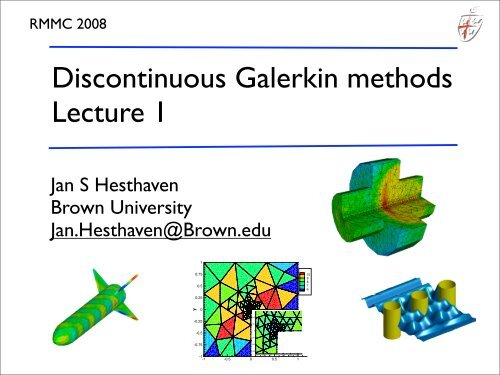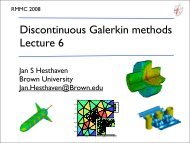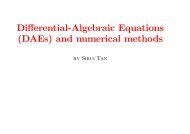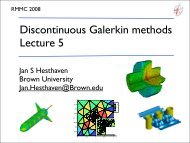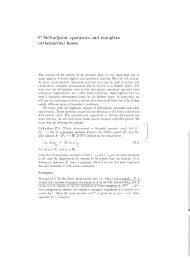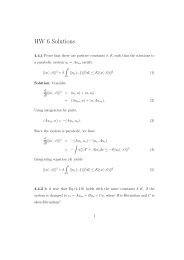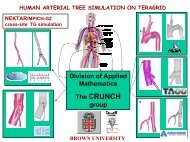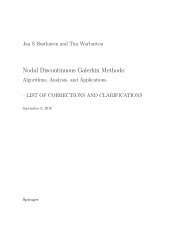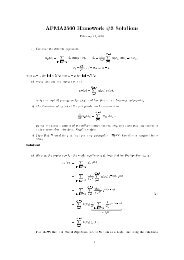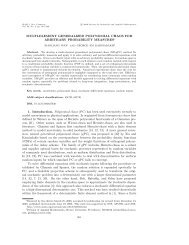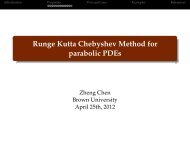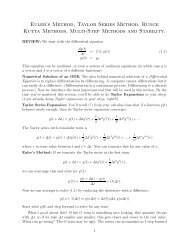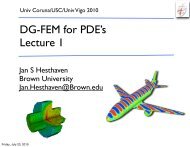Discontinuous Galerkin methods Lecture 1 - Brown University
Discontinuous Galerkin methods Lecture 1 - Brown University
Discontinuous Galerkin methods Lecture 1 - Brown University
Create successful ePaper yourself
Turn your PDF publications into a flip-book with our unique Google optimized e-Paper software.
RMMC 2008<br />
<strong>Discontinuous</strong> <strong>Galerkin</strong> <strong>methods</strong><br />
<strong>Lecture</strong> 1<br />
Jan S Hesthaven<br />
<strong>Brown</strong> <strong>University</strong><br />
-0.75<br />
Jan.Hesthaven@<strong>Brown</strong>.edu x<br />
y<br />
y<br />
1<br />
0.75<br />
0.5<br />
0.25<br />
0<br />
-0.25<br />
-0.5<br />
-1<br />
-1 -0.5 0 0.5 1<br />
1<br />
0.75<br />
0.5<br />
0.25<br />
0<br />
-0.25<br />
-0.5<br />
-0.75<br />
1.203<br />
1.142<br />
1.081<br />
1.019<br />
0.958<br />
0.896<br />
0.835<br />
0.774<br />
0.712<br />
0.651<br />
0.590<br />
0.528<br />
0.467<br />
0.405<br />
0.344<br />
0.283<br />
0.221<br />
0.160<br />
0.099<br />
0.037<br />
y<br />
1<br />
0.75<br />
0.5<br />
0.25<br />
0<br />
-0.25<br />
-0.5<br />
-0.75<br />
8.4 Scattering about a vertical cylinder in a finite-width channel -0.0881 147<br />
10<br />
0.75<br />
9<br />
test the consistency of the imposed bound-<br />
8<br />
7<br />
ary conditions and investigate 0.5<br />
6how<br />
the geo-<br />
0<br />
cal model based on the linear Padé (2,2) ro-<br />
0.02<br />
tational velocity version we set up a test-0.25 for<br />
0.01<br />
open-channel flow. We seek to model the scat-<br />
0<br />
-0.5<br />
tering of an incident wave field which is prop-<br />
-0.01<br />
y<br />
-0.02<br />
der positioned -0.03 in the middle of a finite-width<br />
-0.03 -0.02 -0.01 0 0.01 0.02 0.03<br />
x<br />
-1<br />
-1 -0.5 0 0.5 1<br />
x<br />
y<br />
-1<br />
-1 -0.5 0 0.5 1<br />
x<br />
8.4 Scattering about a vertical cylinder in a finitewidth<br />
channel<br />
A numerical study is carried out to both<br />
metric representation of the the domain may 0.25<br />
affect the computed solution. In a numeri-<br />
agating toward a bottom-mounted rigid cylin-<br />
channel.<br />
1<br />
-0.75<br />
Due to the symmetry, the solution is mathe-<br />
y<br />
0.02<br />
0.01<br />
0<br />
-0.01<br />
-0.02<br />
-0.03<br />
-0.0028<br />
-0.0072<br />
-0.0117<br />
-0.0162<br />
-0.0207<br />
-0.0252<br />
-0.0297<br />
-0.0342<br />
-0.0387<br />
-0.0432<br />
-0.0477<br />
-0.0522<br />
-0.0567<br />
-0.0612<br />
-0.0657<br />
-0.0702<br />
-0.0747<br />
-0.0791<br />
-0.0836<br />
1.95E-06<br />
1.70E-06<br />
1.45E-06<br />
1.20E-06<br />
9.45E-07<br />
6.94E-07<br />
4.43E-07<br />
1.92E-07<br />
-5.90E-08<br />
-3.10E-07<br />
-5.61E-07<br />
-8.12E-07<br />
-1.06E-06<br />
-1.31E-06<br />
-1.57E-06<br />
-0.03 -0.02 -0.01 0 0.01 0.02 0.03<br />
-1<br />
x<br />
-1 -0.5 0 0.5 1<br />
Figure 8.12: Scattering x of waves about a<br />
Darmstadt International Workshop, October 2004 – p.79<br />
cylinder in a finite-width channel.
Start by saying thanks!<br />
• To the main organizers<br />
• D. Stanescu and A. Porter (UWY)<br />
• Funding agencies to enable the work<br />
• NSF, ARO, DARPA, AFOSR, Sloan Foundation<br />
• Collaborators over time<br />
• Tim Warburton<br />
• David Gottlieb<br />
• -- and many others
A brief overview of what’s to come<br />
• <strong>Lecture</strong> 1: Introduction, Motivation, History<br />
• <strong>Lecture</strong> 2: Basic elements of DG-FEM<br />
• <strong>Lecture</strong> 3: Linear systems and some theory<br />
• <strong>Lecture</strong> 4: A bit more theory and discrete stability<br />
• <strong>Lecture</strong> 5: Attention to implementations<br />
• <strong>Lecture</strong> 6: Nonlinear problems and properties<br />
• <strong>Lecture</strong> 7: Problems with discontinuities and shocks<br />
• <strong>Lecture</strong> 8: Higher order/Global problems
springer.com<br />
... and it goes on<br />
• Two afternoons with hands-on exercises<br />
• Next week: T Warburton on<br />
2D/3D, parallel, GPU etc<br />
<strong>Lecture</strong>s and exercises<br />
are based on text<br />
54<br />
Nodal <strong>Discontinuous</strong> <strong>Galerkin</strong><br />
Methods: Algorithms, Analysis, and<br />
Applications<br />
Jan S. Hesthaven • Tim Warburton<br />
TEXTS IN APPLIED MATHEMATICS<br />
This book discusses the discontinuous <strong>Galerkin</strong> family of computational <strong>methods</strong><br />
for solving partial differential equations. While these <strong>methods</strong> have been known<br />
since the early 1970s, they have experienced a phenomenal growth in interest during<br />
the last ten to fifteen years, leading both to substantial theoretical developments<br />
and the application of these <strong>methods</strong> to a broad range of problems.<br />
These <strong>methods</strong> are distinct in nature from standard <strong>methods</strong> such as finite element<br />
or finite difference <strong>methods</strong>, often presenting a challenge in the transition<br />
from theoretical developments to actual implementations and applications.<br />
This book is suitable for graduate level classes in applied and computational<br />
mathematics. The combination of an in-depth discussion of the fundamental<br />
properties of the discontinuous <strong>Galerkin</strong> computational <strong>methods</strong> with the availability<br />
of extensive accompanying Matlab based implementations allows students<br />
to gain first-hand experience from the beginning without eliminating theoretical<br />
insight.<br />
Jan S. Hesthaven is a professor of Applied Mathematics at <strong>Brown</strong> <strong>University</strong>.<br />
Tim Warburton is an assistant professor of Applied and Computational<br />
Mathematics at Rice <strong>University</strong>.<br />
isbn 978-0-387-72065-4<br />
Hesthaven<br />
Warburton<br />
TAM<br />
54<br />
Nodal <strong>Discontinuous</strong> <strong>Galerkin</strong> Methods<br />
54<br />
Jan S. Hesthaven<br />
Tim Warburton<br />
TEXTS IN APPLIED MATHEMATICS<br />
Nodal <strong>Discontinuous</strong><br />
<strong>Galerkin</strong> Methods<br />
Algorithms, Analysis, and<br />
Applications<br />
www.nudg.org
<strong>Lecture</strong> 1<br />
• Why do we need something else ?<br />
• The new challenges<br />
• Why high-order schemes seem a good<br />
idea<br />
• The good, the bad, and the ugly on ‘classic’<br />
<strong>methods</strong><br />
• What we need and how we get it<br />
• The first DG-FEM schemes we see<br />
• A bit of history
1 PFlop/s<br />
1 TFlop/s<br />
Moore’s law and the performance gap<br />
1 GFlop/s<br />
1 MFlop/s<br />
1 KFlop/s<br />
Moore’s Moore s Law<br />
Scalar<br />
IBM 7090<br />
UNIVAC 1<br />
EDSAC 1<br />
Super Scalar<br />
CDC 7600<br />
CDC 6600<br />
Vector<br />
IBM 360/195<br />
Cray 1<br />
Super Scalar/Vector/Parallel<br />
TMC CM-5 Cray T3D<br />
Cray 2<br />
Cray X-MP<br />
Parallel<br />
TMC CM-2<br />
ASCI Red<br />
Earth<br />
Simulator<br />
ASCI White<br />
Pacific<br />
1941 1 (Floating Point operations / second, Flop/s)<br />
1945 100<br />
1949 1,000 (1 KiloFlop/s, KFlop/s)<br />
1951 10,000<br />
1961 100,000<br />
1964 1,000,000 (1 MegaFlop/s, MFlop/s)<br />
1968 10,000,000<br />
1975 100,000,000<br />
1987 1,000,000,000 (1 GigaFlop/s, GFlop/s)<br />
1992 10,000,000,000<br />
1993 100,000,000,000<br />
1997 1,000,000,000,000 (1 TeraFlop/s, TFlop/s)<br />
2000 10,000,000,000,000<br />
2003 35,000,000,000,000 (35 TFlop/s)<br />
1950 1960 1970 1980 1990 2000 2010<br />
Current predictions in required<br />
performance needs show a large<br />
H. Meuer, H. Simon, E. Strohmaier, & JD<br />
and growing gap, known as the<br />
- Listing of the 500 most powerful<br />
Computers in the World<br />
- Yardstick: Rmax from LINPACK MPP<br />
performance gap<br />
Ax=b, dense problem<br />
ate<br />
TPP performance<br />
!"#$%&'#$()&#*)#+$,-./01&*2$,"344#*2#<br />
3<br />
Raw performance largely<br />
driven by innovation in<br />
hardware has so far followed<br />
Moore’s law: ‘Bang-per-buck’<br />
doubles every 24 months<br />
38+<br />
What is causing this growing gap ?<br />
Our way of doing science is being transformed as<br />
simulation science matures, enabling entirely new<br />
ways of addressing problems of national interest.<br />
Solving ‘real’ problems introduce new challenges:<br />
• Modeling of very large scale complex systems, incl<br />
unsteady, multi-physics, multi-scale problems<br />
• Treatment of uncertainties and stochastic effects<br />
• Interaction/assimilation with experimental data<br />
• Very large scale data manipulation and<br />
visualization ‘from data to knowledge’<br />
• Very large scale optimization, estimation, design
Can we close the gap ?<br />
FIGURE 1 (software infrastructure)<br />
.. and by paying careful<br />
attention to the dirty<br />
Which algorithms are needed for the next generation of scientific problems? They should<br />
address the statistical challenges of massive dimensions, and the heterogeneous multiscale nature<br />
of the science driver problems.<br />
Infrastructure Issues<br />
Databases of software should be made available to practitioners. Automatic assistance needs to<br />
be provided to help locate the most appropriate algorithm for a given problem and data.<br />
Problems such as how do you communicate the meta-assumptions of your data need to be<br />
resolved. details<br />
We need to be able to assure quality whenever possible, but not set standards<br />
prematurely or too strictly as to inhibit development of new tools and technologies.<br />
‘Parallel scaling is not all’<br />
RECOMMENDATIONS<br />
Software Infrastructure Support<br />
To develop, manage, leverage and maintain the software infrastructure needed for the next<br />
generation of science, sustained infrastructure and facility support will be required.<br />
.. only by developing more<br />
advanced algorithms
Can we close the gap ?<br />
It is the algorithms, their analysis, and implementation<br />
that are the hard components of this quest toward<br />
real simulations<br />
• Complex to develop and implement<br />
• Very labor intensive (manpower, hero program.)<br />
• Long lived (20-30 years vs 3-5 for hardware)<br />
• Costly !<br />
Question:<br />
Can we hope to mimic the success of standard packages<br />
for linear algebra and ODE’s on PDE’s ?
What should we require ?<br />
The challenges are very substantial<br />
• Steady and unsteady<br />
• Complex geometries<br />
• Multi physics<br />
• Many scales in space and time<br />
We must require a number of key properties<br />
• Flexibility in both geometry and problem types<br />
• Robustness<br />
• Efficiency/high performance/hardware suitable<br />
• ... high-order/variable order accuracy<br />
This is a tall order at best !
Why high-order accuracy ?<br />
We may be able to agree on most of the properties -<br />
except perhaps that on high-order<br />
General concerns/criticism<br />
• High-order accuracy is not needed for real appl.<br />
• The <strong>methods</strong> are not robust<br />
• They only work for smooth problems<br />
• They are hard to do in complex geometries<br />
• They are too expensive<br />
• etc<br />
After having worked on these <strong>methods</strong><br />
for 15 years, I have heard them all
n June 7, 2006 9:29<br />
Why high-order accuracy ?<br />
Let us first define a high-order method as one having<br />
a truncation order exceeding 2<br />
From local to global approximation<br />
Let us consider a simple time-dependent problem<br />
ample 1.1 Consider the wave equation<br />
∂u<br />
∂t<br />
= −2π ∂u<br />
∂x<br />
u(x, 0) = e sin(x) ,<br />
0 ≤ x ≤ 2π, (1.1)<br />
h periodic boundary conditions.<br />
The We exactshall solution solve to Equation it using (1.1) two isdifferent a right-moving ways wave of the form<br />
u(x, t) = e sin(x−2πt) • A standard 2nd order finite difference method<br />
,<br />
• A Fourier spectral method - an ‘infinite order’ method<br />
, the initial condition is propagating with a speed 2π.
U(x,<br />
1.5<br />
Why high-order accuracy ?<br />
0.5<br />
U(x,t)<br />
U(x,t)<br />
1.0<br />
0.0<br />
0 p/2 p<br />
x<br />
3p/2 2p<br />
3.0<br />
2.5<br />
2.0<br />
1.5<br />
1.0<br />
0.5<br />
N = 200<br />
t = 100.0<br />
0.0<br />
0 p/2 p<br />
x<br />
3p/2 2p<br />
3.0<br />
2.5<br />
2.0<br />
1.5<br />
1.0<br />
0.5<br />
N = 200<br />
t = 200.0<br />
0.0<br />
0 p/2 p<br />
x<br />
3p/2 2p<br />
Finite diff.<br />
N=200<br />
U(x,<br />
U(x,t)<br />
U(x,t)<br />
1.5<br />
1.0<br />
0.5<br />
0.0<br />
0 p/2 p<br />
x<br />
3p/2 2p<br />
3.0<br />
2.5<br />
2.0<br />
1.5<br />
1.0<br />
0.5<br />
N = 10<br />
t = 100.0<br />
0.0<br />
0 p/2 p<br />
x<br />
3p/2 2p<br />
3.0<br />
2.5<br />
2.0<br />
1.5<br />
1.0<br />
0.5<br />
N = 10<br />
t = 200.0<br />
0.0<br />
0 p/2 p<br />
x<br />
3p/2 2p<br />
Fourier<br />
N=10<br />
Figure 1.2 An illustration of the impact of using a global method for problems<br />
requiring long time integration. On the left we show the solution of Equation (1.1)<br />
as computed using a second-order centered-difference scheme. On the right we<br />
show the same problem solved using a global method. The full line represents the<br />
computed solution, while the dashed line represents the exact solution.<br />
T=100<br />
T=200<br />
The Fourier<br />
method is about<br />
10 times faster !
Why high-order accuracy ?<br />
Too simple you may say<br />
a)<br />
U(x)<br />
5<br />
4<br />
3<br />
2<br />
1<br />
0<br />
-1<br />
-2<br />
-3<br />
-4<br />
-5<br />
0 ! 2!<br />
x<br />
N=64<br />
t=0.0<br />
b)<br />
U(x)<br />
5<br />
4<br />
3<br />
2<br />
1<br />
0<br />
-1<br />
-2<br />
-3<br />
-4<br />
-5<br />
0 ! 2!<br />
x<br />
N=64<br />
t=100.0<br />
Lack of smoothness does not<br />
destroy the superior properties<br />
... but is high-order accuracy really needed<br />
and what is the cost -- can’t we just run the 2nd<br />
order scheme with more points ?
We arrive at a more straightforward measure o<br />
Why high-order accuracy ?<br />
introducing ...high-order pm(εp, cont’ ν) as a measure of the numbe<br />
ds ν i.e., the error grows linearly in time.<br />
e straightforward measure of the error of the scheme b<br />
) as a measure of the number of points per waveleng<br />
required to guarantee a phase error, ep ≤ εp, afte<br />
How do I solve the problem to a given accuracy, ,<br />
for a specific period of time, , most efficiently ?<br />
Solving wave problems in d-dimensions to time t with<br />
a phase error, ep ≤ εp, after ν periods for a 2m-ord<br />
scheme. accuracyIndeed, from Equation (1.13) we directly<br />
εp this translates into<br />
<br />
νπ<br />
rder cont’<br />
Equation (1.13) we directly obtain the lower bounds<br />
<br />
νπ<br />
p1(ε, ν) ≥ 2π , (1.14<br />
3εp<br />
p2(ε, ν) ≥ 2π 4<br />
p1(ε, ν) ≥ 2π ,<br />
3εp<br />
<br />
πν p2(ε, ν) ≥ 2π<br />
,<br />
15εp<br />
4<br />
d<br />
2m ν<br />
Memory ∝ , Work ∝ (2m)<br />
εp<br />
<br />
πν<br />
15εp<br />
d d+1<br />
2m ν<br />
ν .<br />
εp<br />
Here So 2m we >2also advantageous have in cases where<br />
• 2m = order of the scheme<br />
εp ≪ 1, i.e., when high accuracy is required.<br />
actical way to address this is by using a<br />
r-order scheme – Truncation error exceeds 2.<br />
• d = dimension of the problem<br />
hows that the phase error behaves as<br />
• the number of points per wavelength<br />
cific error εp.<br />
em(p, ν) ∝ νp −2m ⇒ p(ν, εp) ∝ 2m<br />
<br />
ν<br />
,<br />
ν ≫ 1, i.e., when long time integration is needed.<br />
on pm, ensuring a specific error εp.<br />
d>1, i.e., for multi-dimensional problems.<br />
It is immediately apparent that for long time inte<br />
pparent that for long time integrations (large ν), p2 ≪ p<br />
pm < 10, i.e., efficient discretizations of large problems.<br />
justifying the use of high-order schemes. In the f<br />
high-order schemes. In the following examples, we wi<br />
εp
Why<br />
14<br />
high-order<br />
From local<br />
accuracy<br />
to global approximation<br />
?<br />
350<br />
300<br />
250<br />
200<br />
150<br />
100<br />
50<br />
e p = 0.1<br />
0<br />
0 0.25 0.5 0.75 1<br />
n<br />
W 1<br />
W 2<br />
W 3<br />
3500<br />
3000<br />
2500<br />
2000<br />
1500<br />
1000<br />
500<br />
0<br />
e p = 0.01<br />
W 1<br />
W 2<br />
W 3<br />
0 0.25 0.5 0.75 1<br />
n<br />
High-order Figure 1.3 is The the growthright of the work solution function, Wm, forif various : finite difference<br />
schemes is given as a function of time, ν, in terms of periods. On the left we show<br />
the growth for a required phase error of εp = 0.1, while the right shows the result<br />
• High accuracy is required - and it increasingly is !<br />
of a similar computation with εp = 0.01, i.e., a maximum phase error of less than<br />
1%. • Long time integration is needed<br />
• High-dimensional problems (3D) are considered<br />
• Memory restrictions become a bottleneck<br />
• .. apart from that, these <strong>methods</strong> are superior<br />
for hardware with deep memory hierarchies<br />
where C F Lm = c t<br />
refers to the C F L bound for stability. We assume that the<br />
x<br />
fourth-order Runge–Kutta method will be used for time discretization. For this<br />
method it can be shown that C F L1 = 2.8, C F L2 = 2.1, and C F L3 = 1.75.<br />
Thus, the estimated work for second, fourth, and sixth-order schemes is<br />
W1 30ν ν<br />
<br />
ν<br />
, W2 35ν , W3 48ν 3<br />
<br />
ν<br />
. (1.15)<br />
εp<br />
εp<br />
εp
to advance the equations in time, there is likewise a wide v<br />
forHow the integration do we achieve of systems this of? ordinary differential equ<br />
choose among. With such a variety of successful and well te<br />
is tempted Let us consider to ask why a few there well known is a need schemes to consider and their yet anoth<br />
basic To appreciate properties this, to understand let us beginwhat by attempting is needed. to unders<br />
and weaknesses of the standard techniques. We consider th<br />
scalar Consider conservation the basic lawequation for the solution u(x, t)<br />
∂u<br />
∂t<br />
+ ∂f<br />
∂x<br />
= g, x ∈ Ω,<br />
subject All schemes to an appropriate involve two set choices of initial conditions and boun<br />
the boundary, ∂Ω. Here f(u) is the flux, and g(x, t) is some<br />
function. • In which way does one approximate the solution ?<br />
• The In which construction way should of any the numerical approximation method satisfy for solving a<br />
equation the requires PDE ? one to consider the two choices:<br />
• How does one represent the solution u(x, t) by an app
Finite difference <strong>methods</strong><br />
roduction<br />
neighborhood of each grid point xk 1 Introduction<br />
, the solution and the flux are as<br />
d by local polynomials<br />
• The local approximation is a 1D polynomial<br />
• The equation is satisfied in a pointwise manner<br />
t, in the neighborhood of each grid point xk , the solution and the flux are assumed to be w<br />
roximated by local polynomials<br />
1 Introduction<br />
own in space and spatial derivatives are approximated by difference metho<br />
at is, the conservation law is approximated as<br />
duh(xk ,t)<br />
+<br />
dt<br />
fh(xk+1 ,t) − fh(xk−1 ,t)<br />
hk + hk−1 = g(x k ∈ [x<br />
,t), (1<br />
k−1 ,x k+1 2<br />
]: uh(x, t) = ai(t)(x − x<br />
i=0<br />
k ) i 2<br />
, fh(x, t) = bi(t)(x −<br />
i=0<br />
efficients ai(t) and bi(t) are found by requiring that the approximat<br />
he grid points, xk x ∈ [x<br />
. Inserting these local approximations into Eq.(1.1<br />
k−1 ,x k+1 2<br />
]: uh(x, t) = ai(t)(x − x<br />
i=0<br />
k ) i 2<br />
, fh(x, t) = bi(t)(x − x<br />
i=0<br />
k ) i ,<br />
re the coefficients ai(t) and bi(t) are found by requiring that the approximate function in<br />
ates at the grid points, xk . Inserting these local approximations into Eq.(1.1), results in<br />
dual<br />
x ∈ [x k−1 ,x k+1 ]: Rh(x, t) = ∂uh + ∂fh − g(x, t).
Finite difference schemes<br />
• Main benefits<br />
• Simple to implement and fast<br />
• High-order is feasible<br />
• Explicit in time<br />
• Direction can be exploited - upwind<br />
• Strong theory<br />
• Main problem<br />
• Simple local approximation and geometric<br />
flexibility are not agreeable
to unstructured grids in high dimensions, thus ensuring the desired g<br />
more, the construction of the interface fluxes can be done in various<br />
needs to abandon the simple one-dimensional approximation in favor of som<br />
thing more general. The most natural approach is to introduce an elemen<br />
tforward.<br />
Finite volume <strong>methods</strong><br />
based discretization. Hence, we assume that Ω is represented by a collecti<br />
of elements, D k lem and the subsequent evaluation of the fluxe<br />
s<br />
to<br />
reconstruction<br />
the particular equations<br />
problem<br />
(see, e.g.,<br />
and<br />
[218,<br />
the<br />
303]).<br />
subsequent<br />
This is particularly<br />
evalu<br />
nt nonlinear waysconservation and, typically the laws. details simplexes of or cubes, thisorganized lead toin different<br />
an unstructur<br />
ressed in many different ways and the details of this<br />
If, however, we wish to increase the order of accuracy of the met<br />
emerges. Consider again the problem in one dimension. We wish to rec<br />
the interface and we seek a local polynomial, uh(x) of the form<br />
manner to fill the physical domain.<br />
A method closely related to the finite difference method, but with add<br />
geometric flexibility, is the finite volume method. In its simplest form, t<br />
solution u(x, t) is approximated on the element by a constant, uk (t), at t<br />
center, xk , of the element. Thisx is ∈ introduced [x into Eq. (1.1) to recover t<br />
cellwise residual<br />
k−1/2 ,x k+3/2 , f ]: uh(x) =a + bx.<br />
k+1/2 = f(u k+1/2 u ),<br />
k+1/2 = uk+1 + uk n to the reconstruction problem is to use<br />
le and natural solution to the reconstruction proble<br />
k+1/2 = u k+1 + u k<br />
We then require<br />
2<br />
• The local approximation is a cell average<br />
x ∈ D k : Rh(x, t) = ∂uk<br />
∂t + ∂f(uk )<br />
k+1/2<br />
x ∂x<br />
uh(x) dx = h k u k ,<br />
− g(x, t),<br />
x k+3/2<br />
rnatively, one could be tempted to simply take<br />
where the element is defined as D k =[xk−1/2 ,xk+1/2 ] with xk+1/2 = 1<br />
2 (xk<br />
xk+1 x<br />
). In the finite volume method we require that the cell average of t<br />
residual vanishes identically, leading to the scheme<br />
k−1/2<br />
xk+1/2 • The equation is satisfied on conservation form<br />
uh(x) dx = h k<br />
k duk<br />
h<br />
dt + f k+1/2 − f k−1/2 = h k g k to recover the two coefficients. The reconstructed value of the solu<br />
f(uh(x<br />
, (1.<br />
k+1/2 ,<br />
)) can then be evaluated.<br />
2<br />
2<br />
To reconstruct the interface values at a higher accuracy we can c<br />
local h this solution turns of the out form to not be a good idea for general<br />
f k+1/2 = f(uk )+f(u k+1 )<br />
t be a good idea for general nonlinear problem<br />
for each cell. Note that the approximation and the scheme is purely loc<br />
uidistant grids these <strong>methods</strong> all reduce to the finite<br />
p<br />
2<br />
, f k+1/2 =<br />
ewise for f k−1/2 . Alternatively, one could be tempte<br />
f k+1/2 = f(uk )+f(u k
evaluation of these fluxes is not straightforward.<br />
Finite<br />
This reconstruction<br />
volume<br />
problem<br />
<strong>methods</strong><br />
and the subsequent evaluation of the fluxes at<br />
the interfaces can be addressed in many different ways and the details of this<br />
lead to different finite volume <strong>methods</strong>. A simple solution to the reconstruction<br />
problem is to use<br />
The key challenge is one of reconstruction<br />
u k+1/2 = uk+1 + uk , f<br />
2<br />
k+1/2 = f(u k+1/2 ),<br />
• Main benefit<br />
• Robust and fast due to locality<br />
• Complex geometries 2<br />
• Well suited for conservation laws<br />
• Explicit in time<br />
and likewise for f k−1/2 . Alternatively, one could be tempted to simply take<br />
f k+1/2 = f(uk )+f(uk+1 )<br />
,<br />
although this turns out to not be a good idea for general nonlinear problems.<br />
For linear problems and equidistant grids these <strong>methods</strong> all reduce to the finite<br />
difference method. However, one easily realizes that the formulation is less<br />
restrictive in terms of the grid structure; that is, the reconstruction of solution<br />
values at the interfaces is a local procedure and generalizes straightforwardly<br />
to unstructured grids in high dimensions, thus ensuring the desired geometric<br />
• Main problem<br />
• Inability to achieve high-order on general grids<br />
due to extended stencils<br />
• Grid smoothness requirements
where the piecewise linear shape function, N<br />
Finite element <strong>methods</strong><br />
We begin by splitting the solution into elements as<br />
i (xj )=δij is the basis function<br />
and uk = u(xk ) remain as the unknowns.<br />
To recover the scheme to solve Eq. (1.1), we define a space of test functions,<br />
x ∈ D<br />
Vh, and require that the residual is orthogonal to all test functions in this<br />
space as<br />
<br />
∂uh ∂fh<br />
+ − gh φh(x) dx =0, ∀φh ∈ Vh.<br />
Ω ∂t ∂x<br />
The details of the scheme is determined by how this space of test functions is<br />
defined. A classic choice, leading to a <strong>Galerkin</strong> scheme, is to require the that<br />
spaces spanned by the basis functions and test functions are the same. In this<br />
particular case we thus assume that<br />
k : uh(x) =u(x k x − xk+1<br />
)<br />
xk − xk+1 + u(xk+1 )<br />
x<br />
where the linear Lagrange polynomial, ℓk i (x), i<br />
ℓ k x − xk+1−<br />
i (x) =<br />
xk+i − xk+ With this local element-based model, each elem<br />
other element (e.g., D k−1 and D k share xk ). W<br />
of uh as<br />
• The solution is defined in a nonlocal manner<br />
φh(x) =<br />
K<br />
v(x k )N k (x).<br />
uh(x) =<br />
k=1<br />
• The equation is satisfied globally<br />
K<br />
u(x k )N k (x) = <br />
Since the residual has to vanish for all φh ∈ Vh, this amounts to<br />
<br />
∂uh ∂fh<br />
+ − gh N<br />
Ω ∂t ∂x j where the piecewise linear shape function, N<br />
(x) dx =0,<br />
for j =1...K. Straightforward manipulations yield the scheme<br />
i (<br />
and uk = u(xk ) remain as the unknowns.<br />
To recover the scheme to solve Eq. (1.1), we<br />
Vh, and require that the residual is orthogon<br />
k=1<br />
k
has to vanish for all φh ∈ Vh, this amounts to<br />
<br />
Finite element <strong>methods</strong><br />
∂uh ∂fh<br />
+ − gh N<br />
∂t ∂x j <br />
∂uh ∂fh<br />
+<br />
(x) Ωdx<br />
=0, ∂t ∂x<br />
Ω<br />
This yields the global equation<br />
aightforward manipulations yield the scheme<br />
− gh<br />
<br />
N j (x) dx =0,<br />
for j =1. . . K. Straightforward manipulations yield the scheme<br />
where<br />
M duh<br />
dt + Sf h = Mgh, M duh<br />
dt + Sf h = Mgh, (1.4)<br />
Mij =<br />
<br />
Ω<br />
N i (x)N j (x) dx, Sij =<br />
• Main benefits<br />
• High-order accuracy and complex geometries<br />
can be combined<br />
<br />
Ω<br />
N i j dN<br />
(x)<br />
dx dx,<br />
reflects the globally defined mass matrix and stiffness matrix, respectively. We<br />
vectors of unknowns, uh = [u1 , . . . , uNp T ] , of fluxes, f h = [f1 , . . . , f Np T ] , and<br />
gh =[g1 , . . . , gNp T ] , given on the Np nodes.<br />
This approach, which reflects the essence of the classic finite element method [182,<br />
clearly allows different element sizes. Furthermore, we recall that a main motivation f<br />
<strong>methods</strong> beyond the finite volume approach was the interest in higher-order approxi<br />
extensions • Main are problems relatively simple in the finite element setting and can be achieved by add<br />
degrees of freedom to the element while maintaining shared nodes along the faces o<br />
[197]. • Implicit In particular, in one time can have different orders of approximation in each element, the<br />
local • Not changes well in both suited size and for order, problems known as hp-adaptivity with direction (see, e.g., [93, 94]).<br />
However, the above discussion also highlights disadvantages of the classic continu<br />
ment formulation. First, we see that the globally defined basis functions and the req
volume <strong>methods</strong> (FVM), and finite element <strong>methods</strong> (FEM), as compared with the<br />
discontinuous <strong>Galerkin</strong> finite element method (DG-FEM)]. A represents success,<br />
Lets summarize the observations<br />
while ✕ indicates a short-coming in the method. Finally, a () reflects that the<br />
method, with modifications, is capable of solving such problems but remains a less<br />
natural choice.<br />
Complex High-order accuracy Explicit semi- Conservation Elliptic<br />
geometries and hp-adaptivity discrete form laws problems<br />
FDM ✕ <br />
FVM ✕ ()<br />
FEM ✕ () <br />
DG-FEM ()<br />
residual destroys the locality of the scheme and introduces potential problems<br />
with the stability for wave-dominated problems. On the other hand, this is<br />
precisely the regime where the finite volume method has several attractive<br />
features.<br />
An intelligent combination of the finite element and the finite volume<br />
<strong>methods</strong>, utilizing a space of basis and test functions that mimics the finite<br />
element method but satisfying the equation in a sense closer to the finite<br />
volume method, appears to offer many of the desired properties. This combination<br />
is exactly what leads to the discontinuous <strong>Galerkin</strong> finite element<br />
method (DG-FEM).<br />
To achieve this, we maintain the definition of elements as in the finite<br />
element scheme such that D k =[xk ,xk+1 What we need is a scheme that combines<br />
• The local high-order/flexible element of FEM<br />
• The local statement on the equation for FVM<br />
These are exactly the components of the<br />
<strong>Discontinuous</strong> <strong>Galerkin</strong> Finite Element Method<br />
]. However, to ensure the locality
D<br />
So lets see how we can achieve this<br />
k = D k<br />
uv dx, u k<br />
D =(u, u) k<br />
D ,<br />
oken inner product and norm<br />
h =<br />
K<br />
(u, v) k<br />
D , u<br />
k=1<br />
2 Ω,h =(u, u) Ω,h .<br />
t Ω is only approximated by the union of D k , that is<br />
K<br />
Ω Ωh = D<br />
k=1<br />
k 2.2 Basic elements of the sch<br />
D<br />
,<br />
stinguish the two domains unless needed.<br />
cal information as well as information from the neighintersection<br />
between two elements. Often we will refer<br />
tersections in an element as the trace of the element.<br />
cuss here, we will have two or more solutions or boundme<br />
physical location along the trace of the element.<br />
k Dk+1 Dk-1 x 1<br />
l =L xk-1 xK r =xl k xk r =xl k+1<br />
r =R<br />
Fig. 2.1. Sketch of the geometry for simple one-dimensional ex<br />
basis, ψn(x). A simple example of this could be ψn(x) =xn−1 .<br />
local grid points, xk i ∈ Dk Consider the linear scalar wave equation<br />
∂u ∂f(u)<br />
+ =0, x ∈ [L, R] =Ω,<br />
∂t ∂x<br />
where the linear flux is given as f(u) =au. This is subject to the appro<br />
initial conditions<br />
u(x, 0) = u0(x).<br />
Boundary conditions are given when the boundary is an inflow bou<br />
that is<br />
u(L, t) =g(t) if a ≥ 0,<br />
u(R, t) =g(t) if a ≤ 0.<br />
We approximate Ω by K nonoverlapping elements, x ∈ [x<br />
, and express the polynomial through th<br />
k l ,xkr] = D<br />
illustrated in Fig. 2.1. On each of these elements we express the local so<br />
as a polynomial of order N = Np − 1<br />
x ∈ D k : u k Np <br />
h(x, t) = û k Np <br />
n(t)ψn(x) = u k h(x k i ,t)ℓ k l r<br />
xpress the local solution as a polynomial of order N<br />
Np <br />
k k<br />
: uh(x, t) = û<br />
n=1<br />
It is the multi-element component of FEM/FVM which<br />
gives the geometric flexibility<br />
i (x).<br />
k Np <br />
n(t)ψn(x) = u<br />
i=1<br />
k h(x k i ,t)ℓ k i (x).<br />
two complementary expressions for the local solution. In the first one,<br />
we use a local polynomial basis, ψn(x). A simple example of this could<br />
lternative form, known as the nodal representation, we introduce Np =<br />
∈ D k , and express the polynomial through the associated interpolating<br />
). The connection between these two forms is through the definition of<br />
ûk n. We return to a discussion of these choices in much more detail later;<br />
e that we have chosen one of these representations.<br />
, t) is then assumed to be approximated by the piecewise N-th order<br />
uh(x, t),<br />
K<br />
u(x, t) uh(x, t) = u<br />
k=1<br />
k and the solution is represented as<br />
h(x, t),<br />
native form, known as the nodal representation, we introduce N<br />
(x). The connection betwe<br />
forms is through the definition of the expansion coefficients, ûk i=1<br />
n. W<br />
Here, we have introduced two complementary expressions for the loca<br />
a<br />
tion.<br />
discussion<br />
In the first<br />
of these<br />
one, known<br />
choices<br />
as<br />
in<br />
the<br />
much<br />
modal<br />
more<br />
form,<br />
detail<br />
we use<br />
later;<br />
a local<br />
for now<br />
polyn<br />
assume that we have chosen one of these representations.<br />
The global solution u(x, t) is then assumed to be approxim<br />
piecewise N-th order polynomial approximation uh(x, t),<br />
interpolating Lagrange polynomial, ℓk n=1 i<br />
with a high-order local basis as in FEM:<br />
• on modal form<br />
• on nodal form
sic understanding of the schemes through a simple example.<br />
The first DG schemes<br />
first schemes<br />
So let us consider the scalar problem<br />
e linear scalar wave equation<br />
∂u ∂f(u)<br />
+ =0, x ∈ [L, R] =Ω,<br />
∂t ∂x<br />
near flux is given as f(u) =au. This is subject to the appropriate initial condit<br />
u(x, 0) = u0(x).<br />
onditions are given when the boundary is an inflow boundary, that is<br />
u(L, t) =g(t) if a ≥ 0,<br />
u(R, t) =g(t) if a ≤ 0.<br />
ate Ω by K nonoverlapping elements, x ∈ [x k l ,xk r]=D k , as illustrated in Fig.<br />
e elements we express the local solution as a polynomial of order N<br />
x ∈ D k : u k h(x, t) =<br />
Np <br />
n=1<br />
û k n(t)ψn(x) =<br />
Np <br />
i=1<br />
u k h(x k i ,t)ℓ k i (x).
sic understanding of the schemes through a simple example.<br />
The first DG schemes<br />
firstx schemes ∈ D k : u k k x − xk+1<br />
h(x) =u<br />
xk x − xk<br />
+ uk+1<br />
− xk+1 xk+1 1<br />
= u<br />
− xk k+i ℓ k i (x) ∈ Vh,<br />
So let us consider the scalar problem<br />
e linear scalar wave equation<br />
ise for the flux, f<br />
∂u ∂f(u)<br />
+ =0, x ∈ [L, R] =Ω,<br />
∂t ∂x<br />
near flux is given as f(u) =au. This is subject to the appropriate initial condit<br />
We form the local residual<br />
u(x, 0) = u0(x).<br />
onditions are given when the boundary is an inflow boundary, that is<br />
k h . The space of basis functions is defined as Vh = ⊕K <br />
k<br />
k=1 ℓi of piecewise polynomial functions. Note in particular that there is no restric<br />
ss of the test functions between elements.<br />
the finite element case, we now assume that the local solution can be well re<br />
pproximation uh ∈ Vh and form the local residual<br />
x ∈ D k : Rh(x, t) = ∂uk h<br />
∂t + ∂f k h − g(x, t),<br />
∂x<br />
u(L, t) =g(t) if a ≥ 0,<br />
u(R, t) =g(t) if a ≤ 0.<br />
ate Ω by K nonoverlapping elements, x ∈ [xk l ,xkr]=D k lement. Going back to the finite element scheme, we recall that the global c<br />
ual are the source of the global nature of the operators M and S in Eq. (1.4).<br />
equire that the residual is orthogonal to all test functions φh ∈ Vh, leading t<br />
, as illustrated in Fig.<br />
e elements we express the local solution as a polynomial of order N<br />
x ∈ D k : u k h(x, t) =<br />
Np <br />
n=1<br />
û k n(t)ψn(x) =<br />
Np <br />
i=1<br />
i=0<br />
u k h(x k i ,t)ℓ k i (x).
sic understanding of the schemes through a simple example.<br />
The first DG schemes<br />
firstx schemes ∈ D k : u k k x − xk+1<br />
h(x) =u<br />
xk x − xk<br />
+ uk+1<br />
− xk+1 xk+1 1<br />
= u<br />
− xk k+i ℓ k i (x) ∈ Vh,<br />
So let us consider the scalar problem<br />
e linear scalar wave equation<br />
ise for the flux, f<br />
∂u ∂f(u)<br />
+ =0, x ∈ [L, R] =Ω,<br />
∂t ∂x<br />
near flux is given as f(u) =au. This is subject to the appropriate initial condit<br />
We form the local residual<br />
u(x, 0) = u0(x).<br />
onditions are given when the boundary is an inflow boundary, that is<br />
k h . The space of basis functions is defined as Vh = ⊕K <br />
k<br />
k=1 ℓi of piecewise polynomial functions. Note in particular that there is no restric<br />
ss of the test functions between elements.<br />
the finite element case, we now assume that the local solution can be well re<br />
pproximation uh ∈ Vh and form the local residual<br />
x ∈ D k : Rh(x, t) = ∂uk h<br />
∂t + ∂f k h − g(x, t),<br />
∂x<br />
u(L, t) =g(t) if a ≥ 0,<br />
u(R, t) =g(t) if a ≤ 0.<br />
ate Ω by K nonoverlapping elements, x ∈ [xk l ,xkr]=D k lement. Going back to the finite element scheme, we recall that the global c<br />
and require this to vanish locally in a <strong>Galerkin</strong> sense<br />
ual are the source of the global nature of the operators M and S in Eq. (1.4).<br />
equire that the residual is orthogonal to all test functions φh ∈ Vh, leading t<br />
D , as illustrated in Fig.<br />
e elements we express the local solution as a polynomial of order N<br />
k<br />
Rh(x, t)ℓ k j (x) dx =0,<br />
x ∈ D k : u k Np <br />
h(x, t) = û k Np <br />
n(t)ψn(x) = u k h(x k i ,t)ℓ k and the fact that we have duplicated solutions at all interface nodes.<br />
is locality also appears problematic as this statement does not<br />
i (x). allow one to recov<br />
obal solution. Furthermore, the points at the ends of the elements are shared by<br />
n=1<br />
i=1<br />
i=0<br />
1 Introduction<br />
The problem is that all elements are now disconnected<br />
due to the local statement on the residual!<br />
t functions, ℓ k j (x). The strictly local statement is a direct consequence of Vh bein
allow one to recover a meaningful global solution. Furthermore, the points at<br />
theThe ends of first the elements DG schemes<br />
are shared by two elements so how does one ensure<br />
uniqueness of the solution at these points?<br />
These problems are overcome by observing that the above local statement<br />
is very Let similar us apply to that Gauss’s recovered theorem in the finite volume method. Following this<br />
line of thinking, let us use Gauss’ theorem to obtain the local statement<br />
<br />
D k<br />
∂uk h<br />
∂t ℓkj − f k dℓ<br />
h<br />
k j<br />
dx − gℓkj dx = − f k h ℓ kx j<br />
k+1<br />
xk .<br />
What remains now is to understand what the right-hand side means. This is,<br />
however, easily understood by considering the simplest case where ℓk j (x) is<br />
a constant, in which case we recover the finite volume scheme in Eq. (1.3).<br />
Hence, the main purpose of the right-hand side is to connect the elements.<br />
This is further made clear by observing that both element D k and element<br />
D k+1 depends on the flux evaluation at the point, xk+1 , shared among the two<br />
elements. This situation is identical to the reconstruction problem discussed<br />
previously for the finite volume method where the interface flux is recovered<br />
by combining the information of the two cell averages appropriately.<br />
At this point it suffices to introduce the numerical flux, f ∗ k-1<br />
k+1<br />
k<br />
, as the unique<br />
value to be used at the interface and obtained by combining information from<br />
both We elements. have multiple With this we solutions recover the and scheme we need to pick one !
D<br />
The first DG schemes<br />
k+1 depends on the flux evaluation at the point, xk+1 , shared among the t<br />
elements. This situation is identical to the reconstruction problem discus<br />
previously for the finite volume method where the interface flux is recove<br />
by combining the information of the two cell averages appropriately.<br />
At this point it suffices to introduce the numerical flux, f ∗ , as the uni<br />
value to be used at the interface and obtained by combining information fr<br />
both elements. With this we recover the scheme<br />
<br />
D k<br />
∂uk h<br />
∂t ℓkj − f k dℓ<br />
h<br />
k j<br />
dx − gℓkj dx = − f ∗ ℓ kx j<br />
k+1<br />
xk ,<br />
or, by applying Gauss’ theorem once again,<br />
<br />
Rh(x, t)ℓ k j (x) dx = (f k h − f ∗ )ℓ kx j<br />
k+1<br />
2.3 Toward more general formulations 27<br />
ux , f<br />
.<br />
∗ = f ∗ (u −<br />
h ,u+ h ), is again at the very heart of the formulation.<br />
hat it is consistent [i.e., single valued as f(uh) =f ∗ (uh,uh)] when<br />
originating in the hugely successful development of monotone finite<br />
0s, is to require that the flux be chosen so that the scheme reduces<br />
order/finite volume limit. This is ensured by requiring that f ∗ remains now is to understand what the right-hand side means. This is, however, ea<br />
ood by considering the simplest case where ℓ<br />
The lack of solution uniqueness at the interface is<br />
addressed as in FVM by a numerical flux<br />
(a, b)<br />
ment and nonincreasing in the second argument [218].<br />
tonewith flux the is thecorresponding E-flux [251], satisfying strong form being<br />
k j (x) is a constant, in which case we recover<br />
olume scheme in Eq.(1.3). Hence, the main purpose of the right-hand side is to connect<br />
ts. This is further made clear by observing that both element D k and element D k+1 depe<br />
flux evaluation at the point, xk+1 , shared among the two elements. This situation is ident<br />
econstruction problem discussed previously for the finite volume method where the inter<br />
recovered by combining the information of the two cell averages appropriately.<br />
this point it suffices to introduce the numerical flux, f ∗ , as the unique value to be used<br />
erface and obtained by coming information from both elements. With this we recover<br />
<br />
D k<br />
∂uk h<br />
∂t ℓkj − f k dℓ<br />
h<br />
k j<br />
dx − gℓkj dx = − f ∗ ℓ kx j<br />
k+1<br />
xk ,<br />
pplying Gauss’ theorem once again,<br />
D k ∂t ℓ j − f h dx − gℓ j dx = − f h ℓ j x k .<br />
<br />
D k<br />
These two formulations are the discontinuous <strong>Galerkin</strong> finite element (D<br />
FEM) schemes for the scalar conservation law in weak and strong form,<br />
spectively. Note that the choice of the numerical flux, f ∗ ∈ [a, b] : (f<br />
, is a central elem<br />
∗ (a, b) − f(v))(b − a) ≤ 0,<br />
D<br />
l and external value, respectively. The classic finite volume literarical<br />
fluxes with the above properties and we will not attempt to<br />
k<br />
Rh(x, t)ℓ k j (x) dx = (f k h − f ∗ )ℓ kx j<br />
k+1<br />
xk .<br />
two formulations are the discontinuous <strong>Galerkin</strong> finite element (DG-FEM) schemes for<br />
Naturally, the choice of the flux is important !<br />
onservation law in weak and strong form, respectively. Note that the choice of the numer<br />
, is a central element of the scheme and is also where one can introduce the dynamics of<br />
ll [e.g., primarily by upwinding consider through the Lax-Friedrichs the flux as in a finite flux along volumethe method(FVM)]. normal, ˆn,<br />
x k
1 Introduction<br />
The basics of DG-FEM<br />
we have the vectors of local unknowns, u k , of fluxes, f k , and the forcing, g k , all given on the<br />
in each element. Given the duplication of unknowns at the element interfaces, each vector is<br />
ng. Furthermore, we have ℓ k (x) = [ℓk 1(x), . . . , ℓk Np (x)]T and the local matrices<br />
To simplify the notation, introduce<br />
M k ij =<br />
<br />
D k<br />
ℓ k i (x)ℓ k j (x) dx, S k ij =<br />
1 Introduction 9<br />
ℓ<br />
1 Introduction 9<br />
k i (x) dℓkj dx dx.<br />
of the scheme and is also where one can introduce knowledge of the dynamics<br />
of the problem [e.g., by upwinding through the flux as in a finite volume<br />
method (FVM)].<br />
To mimic the terminology of the finite element scheme, we write the two<br />
local elementwise schemes as<br />
M k duk h<br />
dt − (Sk ) T f k h − M k g k h = −f ∗ (x k+1 )ℓ k (x k+1 )+f ∗ (x k )ℓ k (x k of the scheme and is also where one can introduce knowledge of the dynamics<br />
of the problem [e.g., by upwinding through the flux as in a finite volume<br />
method (FVM)].<br />
To mimic the terminology of the finite element scheme, we write the two<br />
local elementwise schemes as<br />
)<br />
M<br />
and<br />
k duk h<br />
dt − (Sk ) T f k h − M k g k h = −f ∗ (x k+1 )ℓ k (x k+1 )+f ∗ (x k )ℓ k (x k to obtain the two basic forms of DG-FEM<br />
Weak:<br />
)<br />
and<br />
M k duk h<br />
dt + Skf k h − M k g k h =(f k h (x k+1 ) − f ∗ (x k+1 ))ℓ k (x k+1 )<br />
−(f k h (x k ) − f ∗ (x k ))ℓ k (x k M<br />
). (1.5)<br />
k duk h<br />
dt + Skf k h − M k g k h =(f k h (x k+1 ) − f ∗ (x k+1 ))ℓ k (x k+1 )<br />
−(f k h (x k ) − f ∗ (x k ))ℓ k (x k e the structure of the DG-FEM is very similar to that of the finite element method (FEM), there<br />
veral fundamental differences. In particular, the mass matrix is local rather than global and<br />
can be inverted at very little cost, yielding a semidiscrete scheme that is explicit. Furthermore<br />
refully designing the numerical flux to reflect the underlying dynamics, one has more flexibility<br />
in the classic FEM to ensure stability for wave-dominated problems. Compared with the FVM<br />
G-FEM overcomes the key limitation on achieving high-order accuracy on general grids by<br />
ing this through the local element-based basis. This is all achieved while maintaining benefits<br />
as local conservation and flexibility in the choice of the numerical flux.<br />
ll of this, however, comes at a price – most notably through an increase in the total degrees<br />
Strong:<br />
edom as a direct result of the decoupling of the elements. For linear elements, this yields a<br />
ling in the total number of degrees of freedom compared to the continuous FEM as discussed<br />
. For certain problems, this clearly becomes an issue of significant importance; that is, if we<br />
a steady solution and need to invert the discrete operator S in Eq.(1.5) then). the associated (1.5)<br />
utational work scales directly with the size of the matrix. Furthermore, for problems where<br />
exibility in the flux choices and the locality of scheme is of less importance (e.g., for elliptic<br />
ems), the DG-FEM is not as efficient as a better suited method like the FEM.<br />
Here we have the vectors of local unknowns, uk h , of fluxes, f k h, and the forcing,<br />
gk Here we have the vectors of local unknowns, u<br />
h , all given on the nodes in each element. Given the duplication of<br />
k h , of fluxes, f k h, and the forcing,<br />
gk h , all given on the nodes in each element. Given the duplication of<br />
<br />
D k
L 2 -errors when solving the wave equation using K elements each<br />
on of the number of elements, K, and the order of the local approximation, N. In<br />
Example 2.4. Consider Eq. (2.1) as<br />
results,<br />
A first example<br />
as . Notewe that observe forseveral N = things. 8, the First, finite the scheme precision is clearly dominates convergentand and dest there<br />
to a converged result; one can increase the local ∂uorder<br />
of ∂uapproximation,<br />
N, and/or<br />
se the number of elements, K.<br />
− 2π =0, x ∈ [0, 2π],<br />
∂t ∂x<br />
Let us consider a simple example<br />
er Eq. (2.1) as<br />
∂u ∂u<br />
− 2π =0, x ∈ [0, 2π],<br />
∂t ∂x<br />
ary conditions and initial condition as<br />
u(x, 0) = sin(lx), l = 2π<br />
λ ,<br />
ength. We use the strong form, Eq. (2.8), although for this simple example, the<br />
ntical results. The nodes are chosen as the Legendre-Gauss-Lobatto nodes as we<br />
il in Chapter 3. An upwind flux is used and a fourth-order explicit Runge-Kutta<br />
to integrate the equations in time with the timestep chosen small enough to<br />
errors can be neglected (See Chapter 3 for details on the implementation).<br />
list a number of results, showing the global L2 with periodic boundary conditions and initial condition as<br />
u(x, 0) = sin(lx), l =<br />
-error at final time T = π as a<br />
ber of elements, K, and the order of the local approximation, N. Inspecting<br />
serve several things. First, the scheme is clearly convergent and there are two<br />
result; one can increase the local order of approximation, N, and/or one can<br />
of elements, K.<br />
2π<br />
λ ,<br />
where λ is the wavelength. We use the strong form, Eq. (2.8), although<br />
weak form yields identical results. The nodes are chosen as the Legendre<br />
shall discuss in detail in Chapter 3. An upwind flux is used and a fourthmethod<br />
is employed to integrate the equations in time with the times<br />
ensure that timestep errors can be neglected (See Chapter 3 for details<br />
In Table 2.1 we list a number of results, showing the global L2-err function of the number of elements, K, and the order of the local ap<br />
these results, we observe several things. First, the scheme is clearly co<br />
roads to a converged result; one can increase the local order of approxi<br />
increase the number of elements, K.<br />
Table 2.1. Global L 2 2.1. Global L<br />
-errors when solving the wave equation using K elem<br />
of approximation, N. Note that for N = 8, the finite precision dominate<br />
convergence rate.<br />
2 -errors when solving the wave equation using K elements each with a lo<br />
roximation, N. Note that for N = 8, the finite precision dominates and destroys the<br />
gence rate.<br />
N\ K 2 4 8 16 32 64 Convergence rate<br />
1 – 4.0E-01 9.1E-02 2.3E-02 5.7E-03 1.4E-03 2.0<br />
2 2.0E-01 4.3E-02 6.3E-03 8.0E-04 1.0E-04 1.3E-05 3.0<br />
4 3.3E-03 3.1E-04 9.9E-06 3.2E-07 1.0E-08 3.3E-10 5.0<br />
8 2.1E-07 2.5E-09 4.8E-12 2.2E-13 5.0E-13 6.6E-13 9.0<br />
e rate by which the results converge are not, however, the same when changing N a<br />
fine h =2π/K as a measure of the size of the local element, we observe that<br />
u − uhΩ,h ≤ Ch N+1 2 4 8 16 32 64 Convergence r<br />
– 4.0E-01 9.1E-02 2.3E-02 5.7E-03 1.4E-03 2.0<br />
2.0E-01 4.3E-02 6.3E-03 8.0E-04 1.0E-04 1.3E-05 3.0<br />
3.3E-03 3.1E-04 9.9E-06 3.2E-07 1.0E-08 3.3E-10 5.0<br />
2.1E-07 2.5E-09 4.8E-12 2.2E-13 5.0E-13 6.6E-13 9.0<br />
asThe a measure error clearly of the behaves size of the as local element, we observe tha<br />
u − uhΩ,h ≤ Ch<br />
.<br />
it is the order of the local approximation that gives the fast convergence rate. The c<br />
es not depend on h, but it may depend on the final time, T , of the solution. To highli<br />
N+1 .<br />
r of the local approximation that gives the fast convergence ra<br />
ich the results converge are not, however, the same when chang<br />
on h, but it may depend on the final time, T , of the solution. T
ount of history<br />
A brief history<br />
alerkin finite element method (DG-FEM) appears to have been<br />
solving the steady-state neutron transport equation<br />
• DG-FEM was first proposed by Reed/Hill in 1973<br />
σu + ∇ · (au) =f,<br />
• First analysis (Lesaint, Raviart,1974) showing in<br />
general and optimal for special<br />
grids.<br />
nstant, a(x) is piecewise constant, and u is the unknown. The fi<br />
sented in [217], showing O(h<br />
• Sharp analysis (Johnson 1986) showed<br />
N )-convergence on a general triangu<br />
rate, O(hN+1 ), on a Cartesian grid of cell size h and with a lo<br />
der N. This result was later improved in [190] to O(hN+1/2 O(h<br />
)-c<br />
ptimality of this convergence rate was subsequently confirmed in<br />
results assume smooth solutions, whereas the linear problems w<br />
zed in [63, 225]. Techniques for postprocessing on Cartesian gr<br />
N ) O(hN+1 )<br />
O(hN+1/2 )<br />
• However the schemes did not enjoy much use
A brief history<br />
• Extension from scalar conservation laws in late<br />
1980’s to system in late 1990’s (Cockburn/Shu)<br />
• Development of limiters and RKDG<br />
• Nodes, modes and large codes (H, Warburton,<br />
Karniadakis etc etc - from 1995)<br />
• Maxwell’s equations, MHD, water waves, elasticity<br />
etc -- last decade has seen explosion<br />
• Higher order problems - IP (Arnold, 1982), BR<br />
(Bassi/Rebay, 1997), LDG (Cockburn/Shu1998)
A brief history<br />
• The last decade has seen an explosion in activities<br />
• Hamilton-Jacobi equations<br />
• Non-coercive problems and spectral accuracy<br />
• Adaptive solution techniques<br />
• Improved solvers<br />
• Advanced time-integration <strong>methods</strong><br />
• Large scale production codes<br />
• etc, etc
A brief overview - and what now ?<br />
• Local flexibility to achieve high-order and<br />
geometric flexibility in the spirit of FEM<br />
• Explicit scheme and ‘problem control’ in the spirit<br />
of FVM
A brief overview - and what now ?<br />
• Local flexibility to achieve high-order and<br />
geometric flexibility in the spirit of FEM<br />
• Explicit scheme and ‘problem control’ in the spirit<br />
of FVM<br />
... but many answers remain unanswered<br />
• How do we achieve high-order accuracy ?<br />
• How do we choose the numerical flux ?<br />
• Is the scheme stable ?<br />
• What is the price ?


